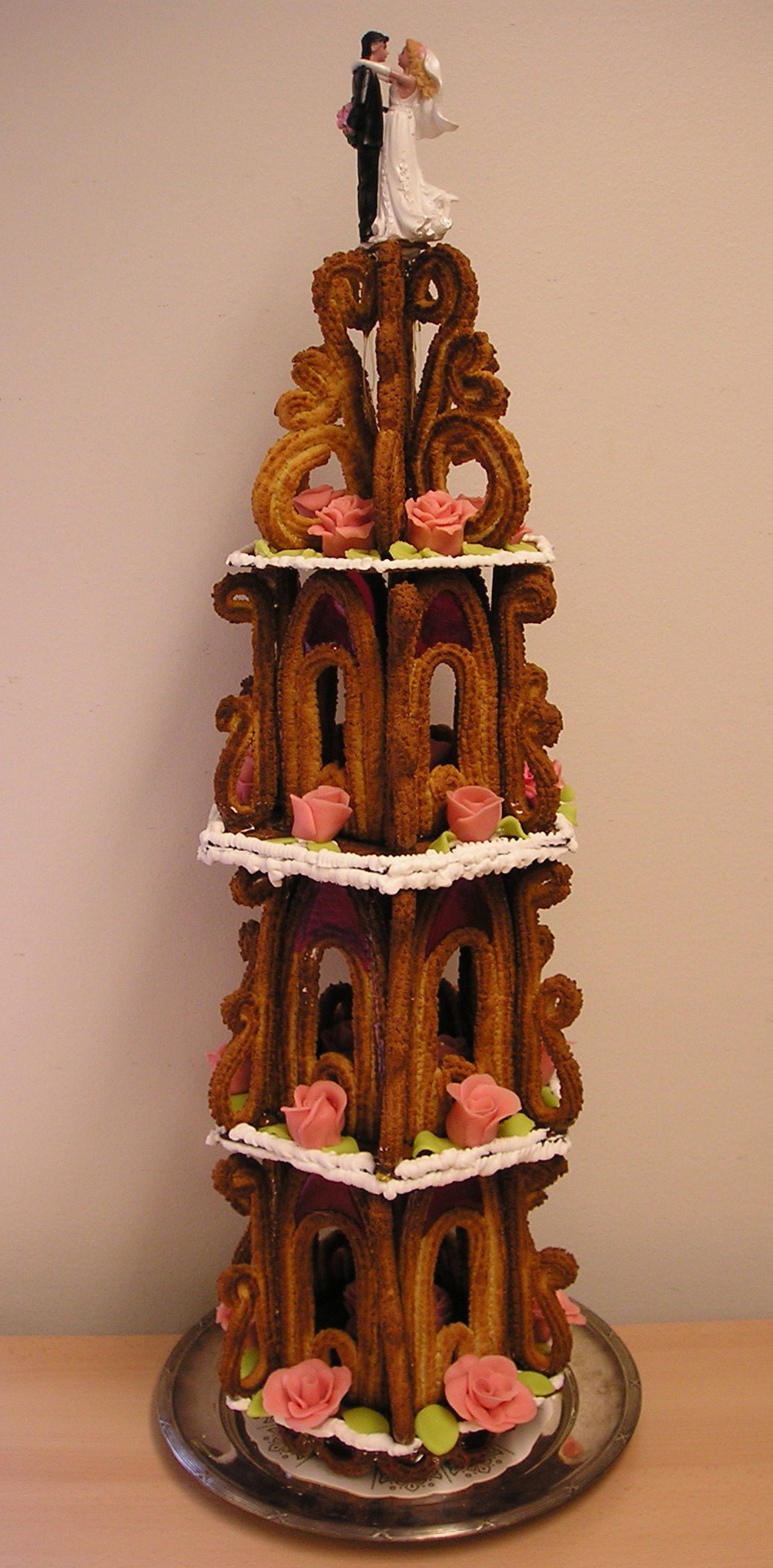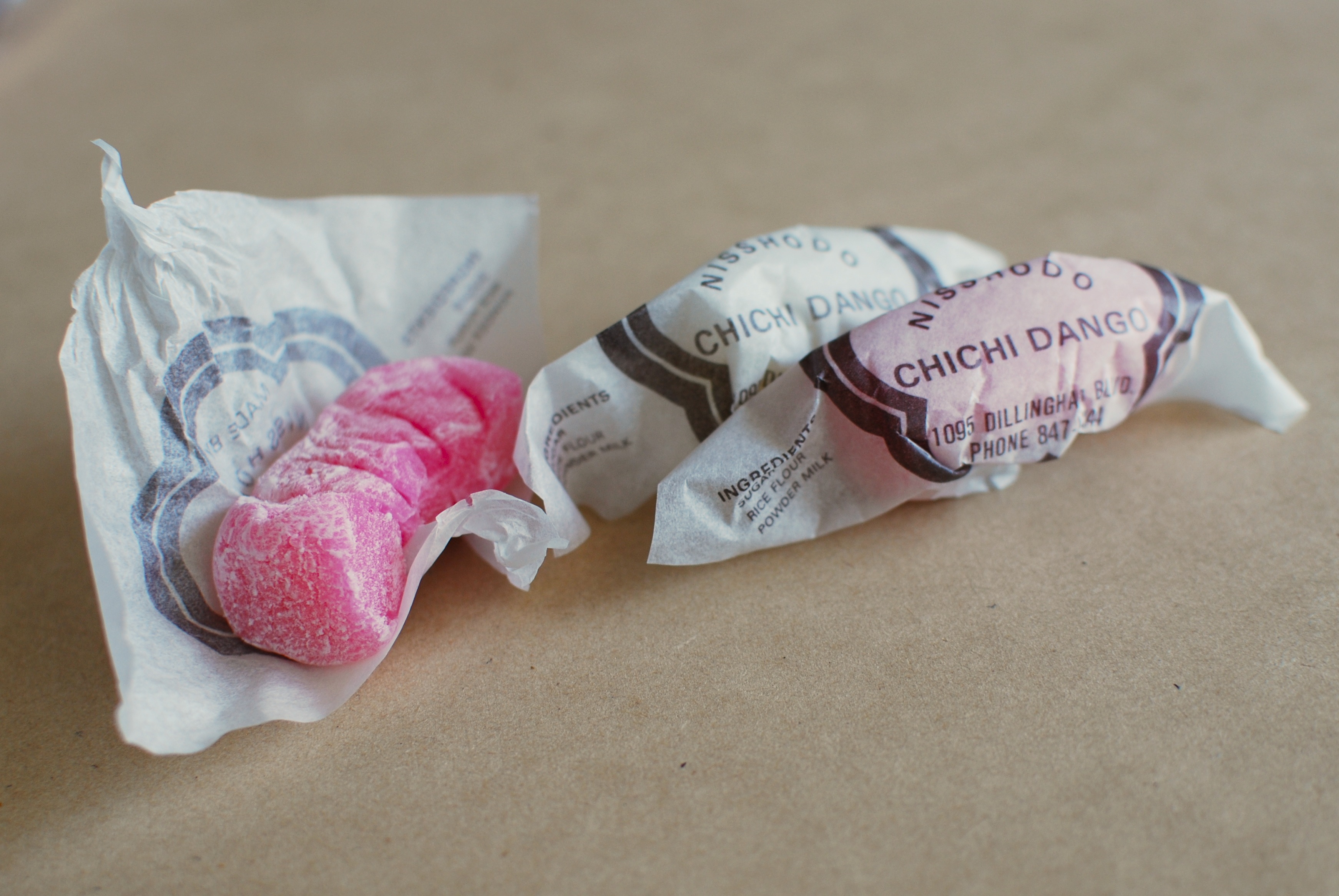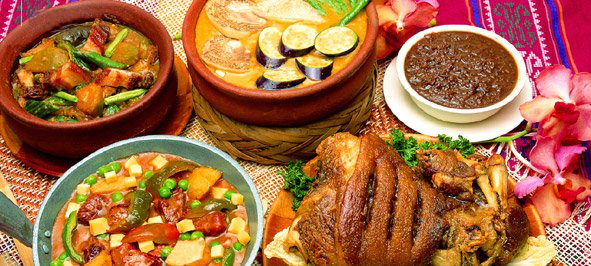|
Butter Mochi
Butter mochi is a cake made from coconut milk, glutinous rice flour (), and butter and is a popular dessert in Hawaiian cuisine. Description Butter mochi combines textures and flavors of its two main influences, mochi and cake. It features a similar chewy ("Q") texture as mochi, but less pronounced through the addition of traditional cake ingredients such as eggs and butter as well as leavening introduced via baking powder. Unlike other mochi, Butter mochi is baked rather than steamed, lending it a color and texture comparable to blondies and chess pie. History The exact origins of butter mochi are unknown. As its primary ingredient, glutinous rice flour, is commonly used in Japan, it is potentially influenced by Japanese immigration to Hawaii, making it a part of fusion cuisine. It can also be considered a descendant of bibingka, a similar cake from Filipino cuisine. Gallery See also * Chichi dango Chi chi dango is a soft, sweet type of dango, a ''mochiko ... [...More Info...] [...Related Items...] OR: [Wikipedia] [Google] [Baidu] |
Mochi
is a Japanese rice cake made of , a short-grain japonica glutinous rice, and sometimes other ingredients such as water, sugar, and cornstarch. The rice is pounded into paste and molded into the desired shape. In Japan, it is traditionally made in a ceremony called . While eaten year-round, mochi is a traditional food for the Japanese New Year, and is commonly sold and eaten during that time. Mochi is a multicomponent food consisting of polysaccharides, lipids, protein, and water. Mochi has a heterogeneous structure of amylopectin gel, starch grains, and air bubbles. The rice used for mochi has a negligible amylose content and a high amylopectin level, producing a gel-like consistency. The protein content of the japonica rice used to make mochi is higher than that of standard short-grain rice. Mochi is similar to , but is made by pounding grains of rice, while dango is made with rice flour. History The process of steaming glutinous rice and making it into a paste ... [...More Info...] [...Related Items...] OR: [Wikipedia] [Google] [Baidu] |
Leavening Agent
In cooking, a leavening agent () or raising agent, also called a leaven () or leavener, is any one of a number of substances used in doughs and batters that cause a foaming action (gas bubbles) that lightens and softens the mixture. An alternative or supplement to leavening agents is mechanical action by which air is incorporated (i.e. kneading). Leavening agents can be biological or synthetic chemical compounds. The gas produced is often carbon dioxide, or occasionally hydrogen. When a dough or batter is mixed, the starch in the flour and the water in the dough form a matrix (often supported further by proteins like gluten or polysaccharides, such as pentosans or xanthan gum). The starch then gelatinizes and sets, leaving gas bubbles that remain. Biological leavening agents * ''Saccharomyces cerevisiae'' producing carbon dioxide found in: ** baker's yeast ** Beer barm (unpasteurised—live yeast) ** ginger beer ** kefir ** sourdough starter * ''Clostridium perfringens' ... [...More Info...] [...Related Items...] OR: [Wikipedia] [Google] [Baidu] |
Hawaiian Fusion Cuisine
Hawaiian may refer to: * Native Hawaiians, the current term for the indigenous people of the Hawaiian Islands or their descendants * Hawaii state residents, regardless of ancestry (only used outside of Hawaii) * Hawaiian language Historic uses * things and people of the Kingdom of Hawaii, during the period from 1795 to 1893 * things and people of the Republic of Hawaii, the short period between the overthrow of the monarchy and U.S. annexation * things and people of the Territory of Hawaii, during the period the area was a U.S. territory from 1898 to 1959 * things and people of the Sandwich Islands, the name used for the Hawaiian Islands around the end of the 18th century Other uses * Hawaiian Airlines, a commercial airline based in Hawaii * Hawaiian pizza, a style of pizza topped with pineapple See also * Hawaiians (other) * Hawaiian cuisine (other) * Hawaiian Islands * Hawaiian kinship Hawaiian kinship, also referred to as the generational system, is a ... [...More Info...] [...Related Items...] OR: [Wikipedia] [Google] [Baidu] |
Baked Goods
Baking is a method of preparing food that uses dry heat, typically in an oven, but can also be done in hot ashes, or on hot stones. The most common baked item is bread but many other types of foods can be baked. Heat is gradually transferred "from the surface of cakes, cookies, and pieces of bread to their center. As heat travels through, it transforms batters and doughs into baked goods and more with a firm dry crust and a softer center".p.38 Baking can be combined with grilling to produce a hybrid barbecue variant by using both methods simultaneously, or one after the other. Baking is related to barbecuing because the concept of the masonry oven is similar to that of a smoke pit. Baking has traditionally been performed at home for day-to-day meals and in bakeries and restaurants for local consumption. When production was industrialized, baking was automated by machines in large factories. The art of baking remains a fundamental skill and is important for nutrition, as ... [...More Info...] [...Related Items...] OR: [Wikipedia] [Google] [Baidu] |
Confectionery
Confectionery is the art of making confections, which are food items that are rich in sugar and carbohydrates. Exact definitions are difficult. In general, however, confectionery is divided into two broad and somewhat overlapping categories: bakers' confections and sugar confections. The occupation of confectioner encompasses the categories of cooking performed by both the French '' patissier'' (pastry chef) and the ''confiseur'' (sugar worker). Bakers' confectionery, also called flour confections, includes principally sweet pastries, cakes, and similar baked goods. Baker's confectionery excludes everyday breads, and thus is a subset of products produced by a baker. Sugar confectionery includes candies (also called ''sweets'', short for ''sweetmeats'', in many English-speaking countries), candied nuts, chocolates, chewing gum, bubble gum, pastillage, and other confections that are made primarily of sugar. In some cases, chocolate confections (confections made of chocola ... [...More Info...] [...Related Items...] OR: [Wikipedia] [Google] [Baidu] |
Hawaiian Desserts
Hawaiian may refer to: * Native Hawaiians, the current term for the indigenous people of the Hawaiian Islands or their descendants * Hawaii state residents, regardless of ancestry (only used outside of Hawaii) * Hawaiian language Historic uses * things and people of the Kingdom of Hawaii, during the period from 1795 to 1893 * things and people of the Republic of Hawaii, the short period between the overthrow of the monarchy and U.S. annexation * things and people of the Territory of Hawaii, during the period the area was a U.S. territory from 1898 to 1959 * things and people of the Sandwich Islands, the name used for the Hawaiian Islands around the end of the 18th century Other uses * Hawaiian Airlines, a commercial airline based in Hawaii * Hawaiian pizza, a style of pizza topped with pineapple See also * Hawaiians (other) * Hawaiian cuisine (other) * Hawaiian Islands * Hawaiian kinship Hawaiian kinship, also referred to as the generational system, is a ... [...More Info...] [...Related Items...] OR: [Wikipedia] [Google] [Baidu] |
Foods Containing Coconut
Food is any substance consumed by an organism for nutritional support. Food is usually of plant, animal, or fungal origin, and contains essential nutrients, such as carbohydrates, fats, proteins, vitamins, or minerals. The substance is ingested by an organism and assimilated by the organism's cells to provide energy, maintain life, or stimulate growth. Different species of animals have different feeding behaviours that satisfy the needs of their unique metabolisms, often evolved to fill a specific ecological niche within specific geographical contexts. Omnivorous humans are highly adaptable and have adapted to obtain food in many different ecosystems. The majority of the food energy required is supplied by the industrial food industry, which produces food with intensive agriculture and distributes it through complex food processing and food distribution systems. This system of conventional agriculture relies heavily on fossil fuels, which means that the food and agricultur ... [...More Info...] [...Related Items...] OR: [Wikipedia] [Google] [Baidu] |
Chichi Dango
Chi chi dango is a soft, sweet type of dango, a ''mochiko'' (sweet rice flour) dessert Dessert is a course (food), course that concludes a meal. The course consists of sweet foods, such as confections, and possibly a beverage such as dessert wine and liqueur. In some parts of the world, such as much of Greece and West Africa, and ... confection of Japanese origin. It is popular in Hawaii, particularly during Girl's Day celebrations. See also * Mochi * Botan Rice Candy * Hawaiian cuisine References Hawaiian cuisine Rice dishes Confectionery {{Confection-stub ... [...More Info...] [...Related Items...] OR: [Wikipedia] [Google] [Baidu] |
Filipino Cuisine
Filipino cuisine ( fil, lutong Pilipino/pagkaing Pilipino) is composed of the cuisines of more than a hundred distinct ethnolinguistic groups found throughout the Philippine archipelago. A majority of mainstream Filipino dishes that compose Filipino cuisine are from the food traditions of various ethnolinguistic groups and tribes of the archipelago, including the Ilocano, Pangasinan, Kapampangan, Tagalog, Bicolano, Visayan, Chavacano and Maranao ethnolinguistic groups. The styles of preparation and dishes associated with them have evolved over many centuries from a largely indigenous (largely Austronesian) base shared with maritime Southeast Asia with varied influences from Chinese, Spanish and American cuisines, in line with the major waves of influence that had enriched the cultures of the archipelago, as well as others adapted to indigenous ingredients and the local palate. [...More Info...] [...Related Items...] OR: [Wikipedia] [Google] [Baidu] |
Bibingka
''Bibingka'' (; ) commonly refers to a type of baked rice cake from the Philippines that is traditionally cooked in a terracotta oven lined with banana leaves and is usually eaten for breakfast or as merienda (mid-afternoon snack) especially during the Christmas season. It can also be used as a general term referring to other Filipino baked rice cakes products, for example, those made with cassava flour (''bibingkang cassava / bibingkang kamoteng kahoy''), glutinous rice (''bibingkang malagkit''), or plain flour. ''Bibingka'' is also found in East Timor and Christian communities in eastern Indonesia. Origins The shared origins of ''bibingka'' from the Philippines and Indonesia is widely acknowledged especially given that the Indonesian ''bibingka'' is from Eastern Indonesia, the regions closest to the Philippines with the most closely related cultures. Some authors have also proposed a connection between the Goan dessert '' bebinca'' (or ''bibik'') and the Southeast Asia ... [...More Info...] [...Related Items...] OR: [Wikipedia] [Google] [Baidu] |
Fusion Cuisine
Fusion cuisine is cuisine that combines elements of different culinary traditions that originate from different countries, regions, or cultures. They can occur naturally and become aspects of culturally relevant cuisines, or they can be part of the post-1970s movement for contemporary restaurant innovations. In July of 2002, the term fuison cuisine was added to the ''Oxford English Dictionary''. It defined it as, "fusion cuisine: originally U.S. a style of cookery which blends ingredients and methods of preparation from different countries, regions, or ethnic groups; food cooked in this style." Categories Fusion food is created by combining various cooking techniques for different cultures to produce a new type of food. Although it is commonly invented by chefs, fusion cuisine can occur naturally within the different cuisines of a region or sub-region. These can include larger regions, such as East Asian cuisine, European cuisine, and Southwestern American cuisine, as well as ... [...More Info...] [...Related Items...] OR: [Wikipedia] [Google] [Baidu] |
Japanese Immigration To Hawaii
The Japanese in Hawaii (simply Japanese or “Local Japanese”, rarely Kepanī) are the second largest ethnic group in Hawaii. At their height in 1920, they constituted 43% of Hawaii's population. They now number about 16.7% of the islands' population, according to the 2000 U.S. Census. The U.S. Census categorizes mixed-race individuals separately, so the proportion of people with some Japanese ancestry is likely much larger. History Contact before 1778 Final voyage of the ''Inawaka-maru'' The first known arrival of Japanese to the Kingdom of Hawaii after Hawaiian contact with James Cook came on May 5, 1806, involving survivors of the ill-fated ship ''Inawaka-maru'' who had been adrift aboard their disabled ship for more than seventy days. The ''Inawaka-maru'', a small cargo ship built in 1798 in Osaka, was owned by Mansuke Motoya. The ''Inawaka-maru'' started its final voyage from Hiroshima to Edo (modern Tokyo) on November 7, 1805. The ship had been chartered by t ... [...More Info...] [...Related Items...] OR: [Wikipedia] [Google] [Baidu] |







